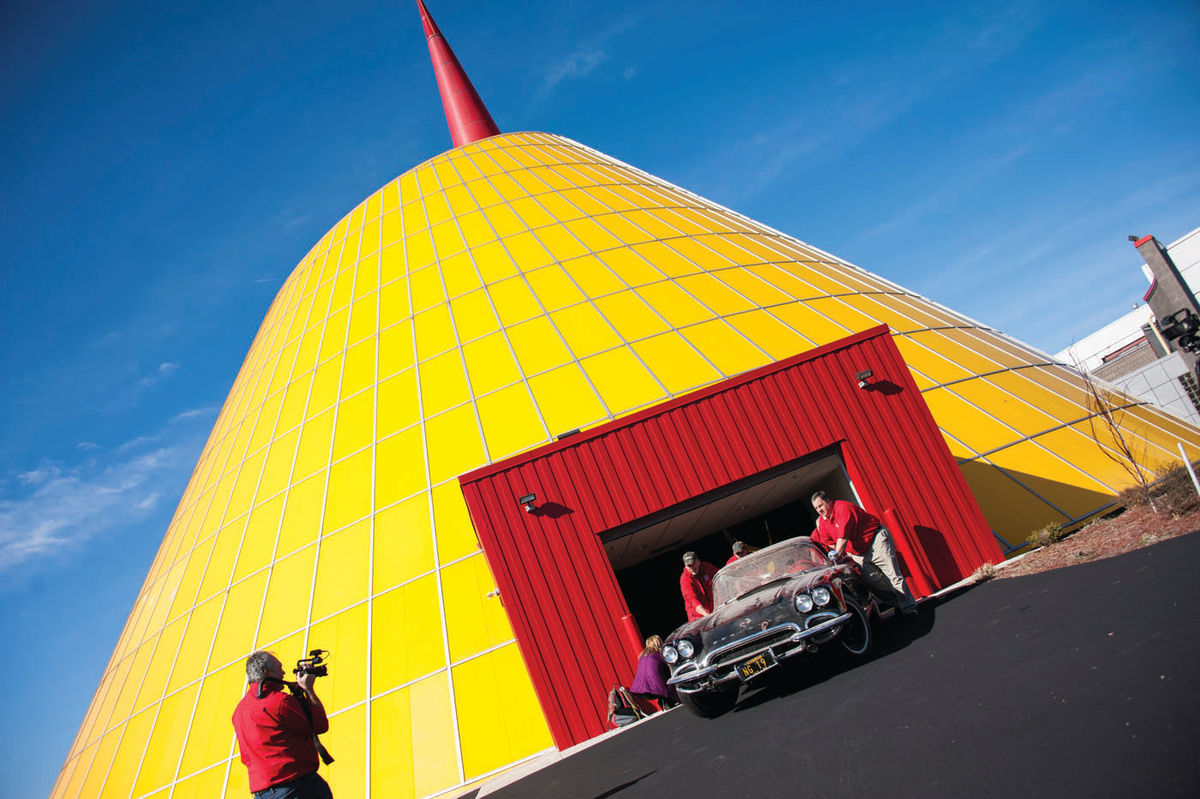The Restoration of the Sinkhole ’62 CORVETTE
One Morning the Earth Opened Under This Museum-Sheltered Car and It Tumbled Down 30 Feet. Now It’s Back In Shape and On Display Again.
On Feb. 12, 2014, people throughout the world turned on their radios and TVs to learn that there was a Corvette museum in Kentucky and that a massive sinkhole had opened below the National Corvette Museum’s yellow Skydome and swallowed eight of the cars on display. The Corvettes took a 30-foot dive, with some landing on top of each other. But, ironically, attendance at the Bowling Green museum took a jump as people flocked there to see the sinkhole and damaged cars.
If You’ve Not Encountered One…
A sinkhole is a depression in the ground, usually in limestone bedrock, caused by water erosion. The cars fell into a kidney bean shaped cave-like depression that was roughly 200 feet long and up to 50 feet wide in some spots. The collapse was recorded by security cameras and some of that footage was shown on TV, helping to boost interest in the debacle.
The damage suffered by each of the cars varied. After they were removed from the sinkhole, it was clear that some could be repaired and some probably could not.
To date, three of the cars have been restored. This is the story of a 1962 Corvette that was involved in the disaster and restored by museum staff members.
Working to Fix the Situation
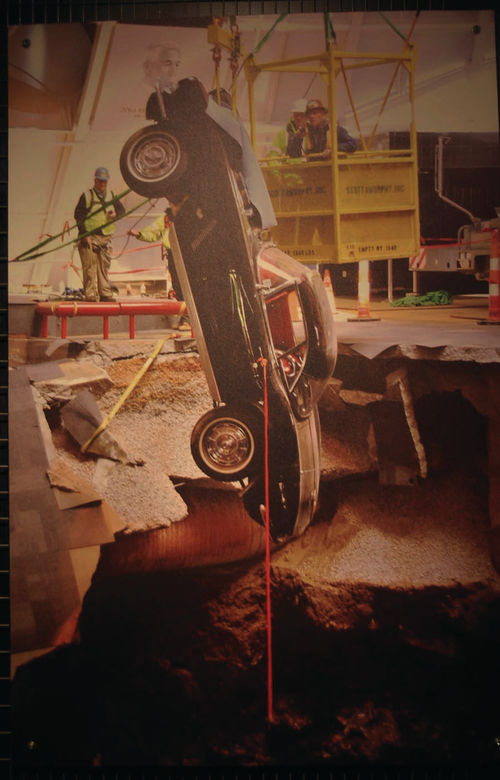


Publicity stemming from the sinkhole literally put the NCM “on the map” nationwide. Many car enthusiasts (especially Corvette fans) had previously known about the museum, but news of the collapse brought many inquisitive members of the general public to the facility.
By 2016 the structural damage had been dealt with and the Skydome was safe. Then, the museum turned the incident into an attraction. A 48-in. manhole was used to access a large cavern that measured 30-ft. high and 20-ft. across in some spots. Visitors could then see into it by peering through a window in the floor of the Skydome.
As the silt from the sinkhole settled, it was determined that five of the Corvettes had sustained damage beyond repair… and some of them were one-of-a-kind cars. The five included a 1984 PPG Pace Car, a 1993 ZR-1 Spyder, a 40th Anniversary Corvette from model year 1993, the 2001 Mallett Hammer Z06 and the 1.5 Millionth Corvette, a 2009.
Another very special car, the 2009 ZR1 Blue Devil, was restored by General Motors Corp. in the fall of 2014 and then unveiled at the SEMA (Specialty Equipment Market Association) Show in Las Vegas, prior to being returned to the NCM. The “One Millionth” Corvette—a 1992 model—was restored through a much more painstaking process. It required four months of work and 1200 man-hours in order to save the signatures of those who had built the car—a top priority.
That left the 1962 Corvette as the one repairable car that had not been restored.
The 1962 Corvette was donated to NCM in 2011 by David Donoho, a diehard enthusiast who saved up enough money to buy the car in high school. He ultimately owned it just over 50 years. David was so obsessed, in fact, that he earned the nickname “The Weather Man” because his friends would tease him about how closely he would watch the weather and quickly take his Corvette home when there was a chance of rain.
“The car has been on display ‘as-is’ for nearly three years, so we thought to commemorate the third anniversary of the sinkhole, we would start restoring the last Corvette to be repaired,” NCM officials said as the project began. “Almost all the work will be performed in-house by Daniel Decker, our Vehicle Maintenance and Preservation Coordinator. It’s exciting that guests will be able to see the car come back to life.”
Restoration Funding Came From the General
The car needed about $15,000 worth of new parts, including a complete front-end assembly, hood panel and windshield, but its damage was minor compared to the other cars.
Fortunately, General Motors wound up covering all $25,000 of the restoration expenses. But returning the 1962 Corvette to original condition was a lengthy process that Daniel Decker expected would take a year to complete.
“It’s a real big honor to be able to do the work, to bring it back to life from the sinkhole,” Decker said.
“We want to do it right. The fiberglass will need to set and cure so it doesn’t shrink. We want it to look immaculate.”
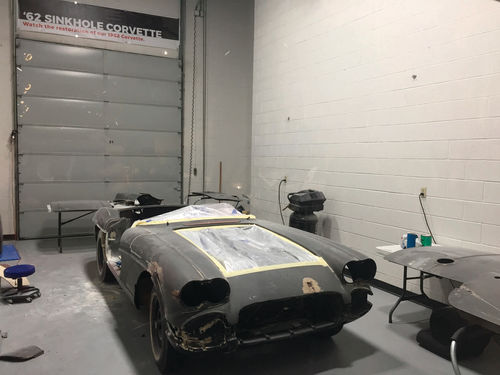


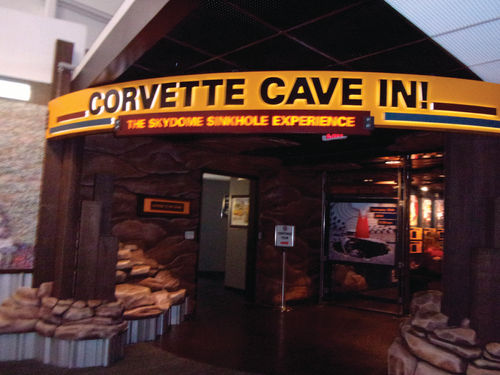
On Feb. 9, 2017 the car—still covered in dirt and debris from the sinkhole— was taken off display in the Skydome and transferred to a garage bay where it was going to be restored. As noted by the museum, all of the work was to be performed in-house so that visitors could see the restoration actually being carried out by NCM staffers.
NCM used Facebook and YouTube to post video updates and progress reports about the restoration. People couldfollow the work at facebook com/corvettemuseum, youtube.com/corvettemuseum or the NCM Website www.corvettemuseum.org.
In November 2017, the NCM newsletter reported, “Work on the 1962 “sinkhole” Corvette has been well underway since February. The goal is to bring it back to the condition it was in when it was donated to the Museum.”
By that date, all of the paint had been stripped and Decker started trimming the broken front fender for re-bonding and fiberglass. The driver side door, hood and trunk lid scratches had all been repaired. “We have received the new rear quarter panel section,” said the report. “So, we have got the old one cut out and the new portion fitted.”
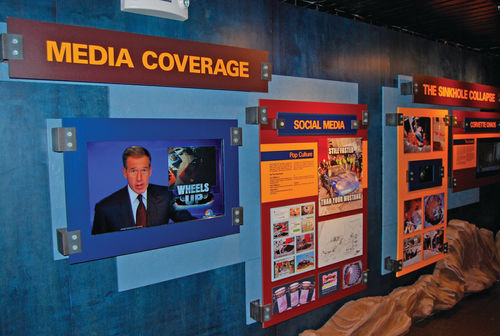



The new and old sections came together before visitors’ eyes on Nov. 3, 2017. From that stage, work continued on the car pretty much every weekday until the work was complete. Museum visitors could observe the worker in action each day until 3p.m.
By January 2018, Decker, NCM Curator Derek Moore and other members of the staff said they were getting close to their goal. By February 12 the restored 1962 was expected to be placed back in its original pre-sinkhole display space in the Skydome and revealed to the public. A ceremony was planned in the Skydome at 9 a.m. and was to be broadcast live on the NCM Facebook page.
Attention to Details… Including a Sugar Packet
On Feb. 12 the car was revealed. “We restored the car to as close as possible to how it was the moment before the sinkhole, the way it was when Mr. Donoho donated the car,” said Moore. “It was a minimal restoration. The frame was straightened a little at the rear, the body pieces or fiberglass components that were damaged or cracked were simply repaired. Only one very small panel on the right side had to have a replacement panel. Everything that we could leave that Mr. Donoho had actually touched or had left on this car (was retained). We wanted to essentially leave his fingerprints on the car.”
While the car was worked on for almost a year, the total time to perform the restoration took about four months of solid work. “You open the hood and the engine is exactly how he left it. The interior is exactly the interior he had in it, the interior that he so lovingly cared for. We didn’t want to take any of that away,” said Moore. “In fact, a few weeks ago an empty sugar packet from Frisch’s Big Boy was found under the seat. We set it aside, finished up the car and then slipped it right back under the seat where it was.”
Donoho, who originally donated the car, had passed away in 2013 before the sinkhole opened. He never saw the damaged or restored Corvette, but his friend and attorney of 20 years, Beth Sease, was present at the unveiling ceremony.
“After the sinkhole occurred, I just shook my head—oh my word,” she said at the time. “Good thing it was only temporary. Thanks to the museum it was only a brief burial.”
Sease pointed out that Donoho initially felt that no one else could care for his 1962 Corvette the way he had, but that the museum had proved him wrong. “The legacy David left was preserved by you and his legacy lives on,” she said. “He’d have been proud to have been here today to see the way you have come together, diligently restoring his prize.”
Turning a Disaster Into a Display
Each year since the sinkhole, NCM has commemorated the anniversary of what could have been an even more devastating day.
In 2016, it opened a special “Corvette Cave-In” exhibition. In 2017, NCM kicked off the restoration of the 1962 Corvette. In 2018, the restored car was unveiled. In 2019, working with a company called LifeLike Imageworks, NCM launched a 360-degree interactive tour of the south side of the cave on its Website. The tour allows virtual visitors to explore nearly every inch of the cave.
“While many visitors and enthusiasts encouraged us to leave the sinkhole as-is, it was not feasible to do so,” explained Katie Ellison, NCM’s Marketing and Communications Manager. “All eight Corvettes are on display in approximately the same spots they were prior to the sinkhole, with five of them looking exactly like they did after being pulled from the depths of the hole. We also offer an interactive exhibition, allowing guests to learn about what happened, the cars affected…how the building was repaired including a time lapse video, and even a live webcam in the cave.
“A lot of people are curious about what it looks like inside the cave, beyond what the webcam shows, so we decided to add this 360-tour to allow them to take a look.”
The 360-degree tour is free to access and can be found on the Museum’s website (www.corvettemuseum.org) by clicking on the Explore–Exhibits menu, then selecting the Corvette Cave-In link.
“The sinkhole story is one that continues to captivate our visitors along with anyone who stumbles upon our security footage of the collapse online,” added Ellison. “It’s a part of not only Museum history, but also Corvette history. We welcome visitors to come check out our immersive displays and learn that story firsthand.”
If you’re in the area or plan on driving through Kentucky, The National Corvette Museum is located at 350 Corvette Dr. in Bowling Green, off I-65’s exit 28. For more, visit corvettemuseum.org or call or 800-53-VETTE ( ).

